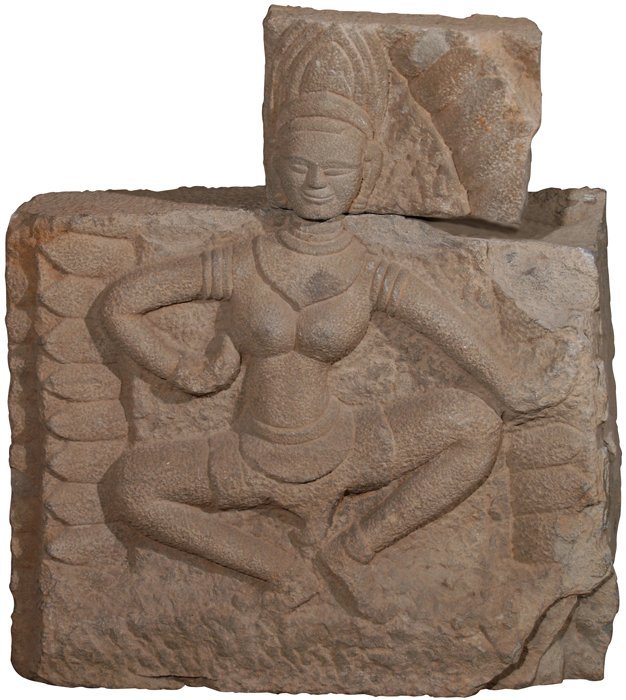12. Dancer, High-relief, Sandstone,
Height 84 cm, Thâp-Mam style,
12th – 13th Century.
Epigraphy offers two inscriptions in Sanskrit, one dated to 658 that was found in central Vietnam in Quang Nam (C96, stele found near My Son E6), the other dated to 668 that was found in Cambodia (the Kdei Ang inscription), that use the term “Champa” for the first time. A description of primitive Lin Yi, its religion, its language or languages, its inhabitants – this all remains under study.
What is better known is the history of the country from the eighth century to, on one hand, the end of Hindu Champa in 1471 when Vijaya fell, and, on the other hand, the period from 1471 to 1832: a slow irregular decline that, from the loss of Kauthara to the annihilation of Panduranga, led to the historically exact conclusion that Champa, as a state, no longer existed. From 1832 on, it was thus part of the conquering, structured, Vietnamese nation, inscribed in frontiers that barely changed until our times with the integration of the Mekong delta.
In the eighth century, then, Champa stretched from the Gate of Annam in the north to the Donnai basin in the south. Probably organised as a confederate state, it was divided into what seem to be principalities, consisting of alluvial plains scored by mountain chains plunging into the sea, called, from north to south, Indrapura, Amaravati, Vijaya, Kauthara and Panduranga. The history of Champa is not only that of the Viet-Cham couple: The country had relations with China of which it was a vassal, to which it paid a tribute and to which it sent ambassadors; with Cambodia, which rapidly (as of the ninth century) became warlike as they did with the Malay world, principally Java, or with the Dai Viet. All these relations were multiple: belligerent, commercial but also matrimonial and, above all, unstable. From the eighth to the fifteenth centuries, Cham civilisation was mainly Hindu (without forgetting Buddhism – essentially in sculpture – from the end of the ninth and the beginning of the tenth centuries), which is to say that it borrowed from India its cults, principally that of Shiva, its language, Sanskrit, its social structure (four classes) and its concept of royalty. An aristocratic elite guaranteed the political, economic and social systems. As for the population, it was composed of farmers, pioneers in aquatic rice cultivation (the variety of rice with a short growth cycle – 100 days – that was born in Champa acted as an important factor in agricultural progress once introduced to southern China in the thirteenth century); merchants who exported sandalwood, cinnamon, rhinoceros horns, elephant tusks; ceramic artisans, specialists in glazing especially from the twelfth to the fifteenth centuries as witnessed by the productions of Go Sanh whose site is near An Nhon, but also sailors who, from the two great ports Tai Chiem (Hoi An region) and Thai Nai (in Binh Dinh) traded or pirated them depending on the period and the demand…
It goes without saying that this social framework was continuously weakened from top to bottom by the various offensive or defensive combats that the Chams had to wage. The first were against the Chinese who tried several times to enlarge their empire toward the south from conquered Annam (“the pacified south” was the highly condescending Chinese name for the Vietnam of those times) and who, to do this, undertook battles that were often victorious. For example, we know that about 446, Tra Kieu, the Cham capital, was devastated by the Chinese general Tan Hezhi who pillaged statues of gold worth a total of 100,000 taels of pure gold, or about 3.6 tons of metal… The second were against the Javanese who destroyed the Po Nagar temple in Nha Trang in 774 and another temple near Vira Pura (the “heroic city”), meaning probably near Phan Rang in the south in 787. But what were only attempts became, as of the tenth century due to the unendurable population increase of the north, a slow but steady devastating southerly push, which culminated in the annihilation of Hindu Champa as witnessed by the destruction of Vijaya by the Dai Viet in 1471.
